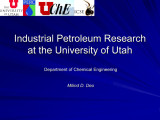TO
Filters: Collection: "ir_eua"
| Title | Date | Subject | Description | ||
|---|---|---|---|---|---|
| 1 |
 |
Recovering hydrocarbons from tar sand or heavy oil reservoirs | 1994-06-07 | hydrocarbon recovery; tar sand; heavy oil; underground tar sand reservoir; patent | Method of recovering fluids from an underground tar sand reservoir or heavy oil reservoir comprising (a) drilling and completing a first pair of wells and a second pair of wells, each pair comprising an injection well terminating in the reservoir and a production well terminating in the reservoir be... |
| 2 |
 |
Thermal drainage process for recovering hot water-swollen oil from a thick tar sand | 1987-05-26 | thermal drainage process; hot water-swollen oil recovery; thick tar sand; oil recovery | Hot liquid-containing water-swollen tar is produced from a tar sand by injecting steam into a well, which is at least initially open and substantially free of obstruction to vertical fluid flow throughout a long vertical interval from the bottom of the tar sand, by producing said liquid from the bot... |
| 3 |
 |
APPENDIX C - In-situ production of Utah oil sands - Final Project Report - Reporting period: June 21, 2006 to October 21, 2009 | 2009-10 | Utah; Uinta Basin; Oil sand reservoirs; Whiterocks; Sunnyside; Oil; Oil extraction; In-situ; Heavy oil production; Bitumen | Two oil sand reservoirs located in Utah's Uinta Basin were considered for analysis: Whiterocks, a small, steeply dipping, contained reservoir containing about 100 million barrels, and Sunnyside, a giant reservoir containing over four billion barrels of oil in place. Cyclic steam stimulation, steam a... |
| 4 |
 |
Heavy oil production operations in Potiguar Basin, Brazil | 1987 | heavy oil production operations; heavy oil; Portiguar Basin; oil fields; oil | The Potiguar basin is located on the northeastern Brazilian coast and comprises an onshore portion with 21,500 km2 (8300 mi2) and its offshore extension (Fig. 1). In the last 4 years, many oil fields have been discovered in the onshore portion, where today's production reaches 20,000 bbl/d. The oil ... |
| 5 |
 |
An analysis of the tar sand deposit on the Rocky Mountain exploration company whiterocks federal lease Uintah County, Utah | 1982-11 | Rocky Mountain Exploration Company (hereafter called Rocky) of Salt Lake City, Utah, and Houston, Texas, holds a 240-acre federal combined hydrocarbon lease in Sections 17 and 18, T 2 N, R 1 E, UE5SM, Uintah County, Utah. The lease lies in the Ashley National Forest. Road distance is 27 miles north ... | |
| 6 |
 |
Chemistry and mineralogy of natural bitumens and heavy oils and their reservoir rocks from the United States, Canada, Trinidad and Tobago, and Venezuela | 1989-12-21 | Twenty-one samples from natural bitumen and heavy oil deposits in seven States of the United States and six samples from outside the United States form the basis of this initial study. This Circular gives the mineral content of the reservoir rock, the trace-element distribution in the reservoir rock... | |
| 7 |
 |
Oil sands production technologies | 2008-02-22 | oil sands; oil sands production; production technologies; Utah oil sands | An overview of oil sands production technologies for Utah reserves. |
| 8 |
 |
Industrial petroleum research at the University of Utah | 2008-03-12 | industrial petroleum; University of Utah; oil and gas characterization; oil and gas thermodynamics; Unconventional Consortium | Expertise: Oil and Gas Characterization, Hydrocarbon Thermodynamics -High-temperature, high high-pressure oil oil-gas mixtures -Supercritical extraction -Solid (asphaltenes, waxes) precipitation precipitation -Reservoir Characterization and Simulation -Fractured reservoir simulation -Reaction chemis... |
| 9 |
 |
Heavy-oil resources of the United States | 1995 | heavy-oil resources; United States; petroleum; heavy oil | Petroleum is considered to originate from marine and terrestrial organic matter (composed principally of hydrogen and carbon) buried along with sediment. The organic molecules are eventually broken by thermal stress encountered during progressive burial. The product of this heating can be liquid and... |
| 10 |
 |
Quantitative methods for reservoir characterization and improved recovery: Application to heavy oil sands | 2002-05-15 | interwell reservoir heterogeneity; heavy oil sands; advanced analytical property-distribution methods | Improved prediction of interwell reservoir heterogeneity is needed to increase productivity and to reduce recovery cost for California's heavy oil sands, which contain approximately 2.3 billion barrels of remaining reserves in the Temblor Formation and in other formations of the San Joaquin Valley. ... |
| 11 |
 |
New algorithms for steam assisted gravity drainage using combinations of vertical and horizontal wells | 1994-04 | steam assisted gravity drainage; vertical and horozontal wells; SAGD; oil sand reservoirs; vertical injectors | New algorithms have been presented for steam assisted gravity drainage (SAGD) in oil sand reservoirs using vertical injectors-producers and vertical injectors-horizontal producers. Although SAGD with a pair of horizontal wells has been reported to be promising, it may be necessary to use a combinati... |
| 12 |
 |
Quantitative methods for reservoir characterization and improved recovery: Application to heavy oil sands | 2001-10-30 | interwell reservoir heterogeneity; heavy oil sands; analytical property-distribution methods; reservoir simulation | Improved prediction of interwell reservoir heterogeneity is needed to increase productivity and to reduce recovery cost for California's heavy oil sands, which contain approximately 2.3 billion barrels of remaining reserves in the Temblor Formation and in other formations of the San Joaquin Valley. ... |
| 13 |
 |
Heavy oil and natural bitumen-strategic petroleum resources | 2003-07 | heavy oil; natural bitumen; strategic petroleum resources; conventional oil; light oil | Because conventional light oil can typically be produced at a high rate and a low cost, it has been used before other types of oil. Thus, conventional oil accounts for a declining share of the Earth's remaining oil endowment. In addition to assessing conventional oil resources, scientists of the U.S... |
| 14 |
 |
Basin oriented strategies for CO2 enhanced oil recovery: Alaska | 2005-04 | Alaska; North Slope; Cook Inlet; Oil; Gas; Oil recovery; EOR; CO2; Carbon dioxide; Oil fields; Oil production industry | The oil and gas producing regions of Alaska have nearly 45 billion barrels of oil which will be left in the ground, or "stranded", following the use of today's oil recovery practices. A major portion of this "stranded oil" is in reservoirs technically and economically amenable to enhanced oil recove... |
| 15 |
 |
The bitumen-bearing Paleozoic carbonate trend of northern Alberta | 1987 | Paleozoic carbonate trend; northern Alberta; bitumen; Cretaceous oil sands; Canada; crude oil; nonconventional oil resources | Huge quantities of bitumen are contained within the Devonian and Mississippian carbonate horizons that subcrop beneath the Cretaceous oil sands of northern Alberta. To date, however, a detailed evaluation of the economic potential of this resource has been confined primarily to the Upper Devonian Gr... |
| 16 |
 |
Basin oriented strategies for CO2 enhanced oil recovery: Rocky Mountain Region | 2006-02 | Rocky Mountain; Colorado; Utah; Wyoming; Oil; Gas; Enhanced oil recovery; EOR; CO2; Carbon dioxide injection; Oil fields; Basin oriented strategies; Domestic oil production | The Rocky Mountain oil and gas producing region of Colorado, Utah and Wyoming has an original oil endowment of nearly 34 billion barrels. Of this, 11 billion barrels (33%) has been produced or proven. As such, nearly 23 billion barrels of oil will be left in the ground, or "stranded", following the ... |
| 17 |
 |
Investigation of tar sand and heavy oil deposits of Utah for underground coal gasification applications | 1985-12 | tar sand; heavy oil deposits; underground coal gasification; UCG applications | A literature review was conducted to determine spatial and geological relationships between Utah's tar sand or heavy oil deposits and coal deposits and to evaluate these relationships in terms of suitability for underground coal gasification (UCG) applications. The investigation was undertaken as pa... |
| 18 |
 |
Reactivation of an idle lease to increase heavy oil recovery through application of conventional steam drive technology in a low dip slope and basin reservoir in the midway-sunset field, San Joaquin Basin, California | 2002-02 | heavy oil recovery; conventional steam drive technology; Midway-Sunset field | A previously idle portion of the Midway-Sunset field, Aera Energy's Pru Fee property, has been brought back into commercial production through tight integration of geologic characterization, geostatistical modeling, reservoir simulation, and petroleum engineering. This property, shut-in over a decad... |
| 19 |
 |
Geologic influences on the in situ processing of tar sand at the northwest Asphalt Ridge deposit, Utah | 1985-01 | in situ oil recovery field experiments; oil recovery; tar sand; in situ tar sand processing; Asphalt Ridge deposit | The Laramie Energy Technology Center, Department of Energy, completed three in situ oil recovery field experiments, two combustion and one steamflood, in tar sand at Northwest Asphalt Ridge, Utah. Inadequate resource and site characterization prior to the field experiments contributed to process des... |
| 20 |
 |
Evaluation of different in-situ recovery strategies | 2006-10 | in-situ recovery strategies; in-situ recovery; oil shale; thermal simulator; oil shale reservoirs; in-situ combustion; in-situ pyrolysis; modified in-situ process | Analysis of different in-situ production strategies from oil shale using a general purpose thermal simulator. |
| 21 |
 |
In situ production of Utah oil sands | 2009-02-27 | in situ; oil sands production; Utah oil sands; in situ process; thermal simulator; thermal compositional model; steam assisted gravity drainage; SAGD; heterogenetics; in-situ combustion; hydraulic fracture; hybrid process | Analysis of issues relevant to in situ production of Utah oil sands, presented at the 2009 Western U.S. Oil Sands Conference by Milind Deo, Professor, Department of Chemical Engineering, University of Utah. |
| 22 |
 |
Geological assessment of heavy-oil reservoirs in the Lloydminster area, using a computerized data base | 1987 | heavy-oil reservoirs; geological assessment; heavy-oil reservoirs; wells | Heavy-oil reservoirs of the Lower Cretaceous Mannville Group in the Lloydminster area (Western Canada) occur in a sequence of complexly arranged sandstones, siltstones, shales, and coals. Trapping mechanisms vary, and the precise geological controls governing hydrocarbon accumulations are not well u... |
| 23 |
 |
In-situ combustion handbook--principles and practices | 1999-01 | in-situ combustion; oil reservoir; oil recovery; field trials; fireflood projects; combustion projects | For nearly 90 years in-situ combustion technique has been used in the U.S. in attempts to improve recovery from oil reservoirs. Despite its long history and commercial success of many field projects, the process has not found widespread acceptance among operators due to the excessive number of failu... |
| 24 |
 |
APPENDIX B - Depositional heterogeneity and fluid flow modeling of the oil shale interval of the upper Green River Formation, eastern Uinta Basin, Utah - Final Project Report - Reporting period: June 21, 2006 to October 21, 2009 | 2009-10 | Green River Formation; Uinta Basin; Utah; Uintah County; Oil shale; Deposition | In this project, a detailed geological analysis was performed followed by a reservoir modeling exercise. For the geological analysis, ~300 m of cores were correlated to gamma and density logs in well P4 in the lower to middle Eocene (49.5-48.0 million years ago (Ma)), upper Green River Formation of ... |
| 25 |
 |
Influence of the geological and geochemical characteristics of heavy oils on their recovery | 1987 | oil buoyancy; heavy oils; Likouala oil field; Emeraude oil field; water washing; oil saturation; biodegradation | The migration of an oil into a trap is governed by its buoyancy, the capillary pressure, and the hydrodynamic forces. For heavy oils the buoyancy is low; therefore, they can only saturate high-permeability zones, which are also preferentially swept by steam in a steam-drive recovery operation. Howev... |
